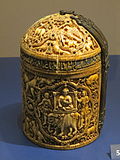Pyxis (vessel)
This article needs additional citations for verification. (November 2011) |

A pyxis (Greek: πυξίς; pl.: pyxides) is a shape of vessel from the classical world, usually a cylindrical box with a separate lid and no handles.[1] They were used to hold cosmetics, trinkets or jewellery, but were also used for dispensing incense and by physicians to contain medicine.[2] Surviving pyxides are mostly Greek pottery, but could also be made from a range of other materials: wood, bronze, ivory, marble, terracotta, silver, or stone.[3] The name derived from Corinthian boxes made of wood from the tree puksos ("boxwood").[3] During the Classical period, the Attic word "kylichnis" was also used to refer to the same shape.[3] The shape of the vessel can be traced in pottery back to the Protogeometric period in Athens, however the Athenian pyxis has various shapes itself.
Types
There were many different varieties of pyxis, popular in different times and places. The earliest were the Protogeometric type of vessel which had a globular body, and the pointed-bottom pyxis from the early Geometric period.[4] The pointed pyxis didn't last much longer than the ninth century BCE. During the later Geometric period another style emerged with a flat, very broad base.[5] Contemporary scholarship classifies pyxides as either: type A, type B, type C, type D, lekanis, Nikosthenic, or tripod.[6]
Nikosthenic type

This type was introduced by Nikosthenes during the late sixth century BCE. It is characterised by a deep, calyx-shaped bowl with a flanged rim and a stemmed foot, and a domed lid.[7] The decorations on pyxides found in an Etruscan context tend towards depictions of battles and athletic contests; for pyxides found in Greek and near eastern Mediterranean settings the depictions tend to be of marriage, childbirth, or religious processions.[8] Evidence suggests that this was a popular type on the eastern Aegean island of Samos and in Etruria between 560–500 BCE.[9]
Proto-Geometric type
Examples of pyxide from the Proto-Geometric style of Greek pottery normaly between roughly 1050 and 900 BCE[10][11][12] include the Globular Pyxis, a type of pyxis characterized with a wide, circular body and a flared lip at the top of the vessel.[13] Other forms of pyxide commonly from the early geometric period include the pointed pyxis is a type of pyxis characteried with a wide tip that thins into a point at the bottom.[13]
Conrinthian type
Corinthian style pyxides usually share similar traits of being less circular than traditional Greek geometric style pyxides. We can see this in the tall convex pyxis,[13] and the 8th century straight-sided pyxis[13] Corinthian styles. Other forms of Corintian pyxyde inclue the Type II: Low Concave-sided pyxis[14] dated around the 5th and 4th centuries BC and the Type III: High Concave-sided pyxis[13] dated ca. late 7th century BC
Gallery
-
Pyxis made out of "Egyptian faience". Imported to Italy from northern Syria. Produced 750–700 BC, Altes Museum.
-
A Roman luxury Pyxis, used to hold cosmetics or precious jewellery - Walters Art Museum
-
Pyxis with four horses, Greece, Attica, Geometric Period, 8th century BC, terracotta - Wadsworth Atheneum - Hartford, CT
-
4th century "Type IV" Athenian pyxis with a depiction of a hand, National Museum, Warsaw
-
Ivory pyxis from Córdoba, Spain, 10th Century AD, Victoria and Albert Museum
-
Example of a "Globular" style Pyxis - Clay pyxis with lid, Protogeometric Period, 10th c. BC
-
Example of a "Type II", Low Concave-sided, Pyxis c. 400 B.C. - Metropolitan Museum of Arts
-
Example of a terracotta "Type III: High Concave-sided" pyxis style
-
Example of a "pointed" style of pyxis, ca. 900-875 BC, Louvre Museum
See also
References
- ^ Folsom 1967, p. 183.
- ^ Roberts 1978, p. 4.
- ^ a b c Roberts 1978, p. 2.
- ^ Folsom 1967, p. 180.
- ^ Folsom 1967, p. 181.
- ^ Perseus Encyclopedia, Pyxis
- ^ Lyons 2009, p. 166.
- ^ Lyons 2009, p. 171.
- ^ Lyons 2009, p. 173.
- ^ Lemos, Irene S (2003-01-09), "Protogeometric Pottery Found in the Eastern Mediterranean", The Protogeometric Aegean, Oxford University PressOxford, pp. 228–229, ISBN 978-0-19-925344-9, retrieved 2024-06-11
- ^ Lemos, Irene S (2003-01-09), "Protogeometric Pottery Found in the Eastern Mediterranean", The Protogeometric Aegean, Oxford University PressOxford, pp. 228–229, ISBN 978-0-19-925344-9, retrieved 2024-06-11
- ^ Sparkes, Brian A. (1991). Greek pottery : an introduction. Internet Archive. Manchester ; New York : Manchester University Press ; New York : Distributed exclusively in the USA and Canada by St. Martin's Press. ISBN 978-0-7190-2236-4.
- ^ a b c d e Folson, Robert (1967). Handbook of Greek Pottery.
- ^ R., G. M. A. (August 1908). "White Athenian Pyxis". The Metropolitan Museum of Art Bulletin. 3 (8): 154. doi:10.2307/3252705. ISSN 0026-1521. Archived (PDF) from the original on June 11, 2024.
Bibliography
- Roberts, Sally (1978). The Attic Pyxis. Ares Publishers.
- Folsom, Robert (1967). Handbook of Greek Pottery. New York Graphic Society Ltd.
- Lyons, Claire (2009). "Nikosthenic pyxides between Etruria and Greece". In Oakley, John; Palagia, Olga (eds.). Athenian Potters and Painters Volume II. Oxbow Books. pp. 166–180. ISBN 978-1-84217-350-3.
- Sparkes, Brian A. (1991). Greek Pottery: An Introduction. Manchester ; New York : Manchester University Press ; New York : Distributed exclusively in the USA and Canada by St. Martin's Press
- Dickinson, Oliver (1994). The Aegean Brone Age. Cambridge University Press








